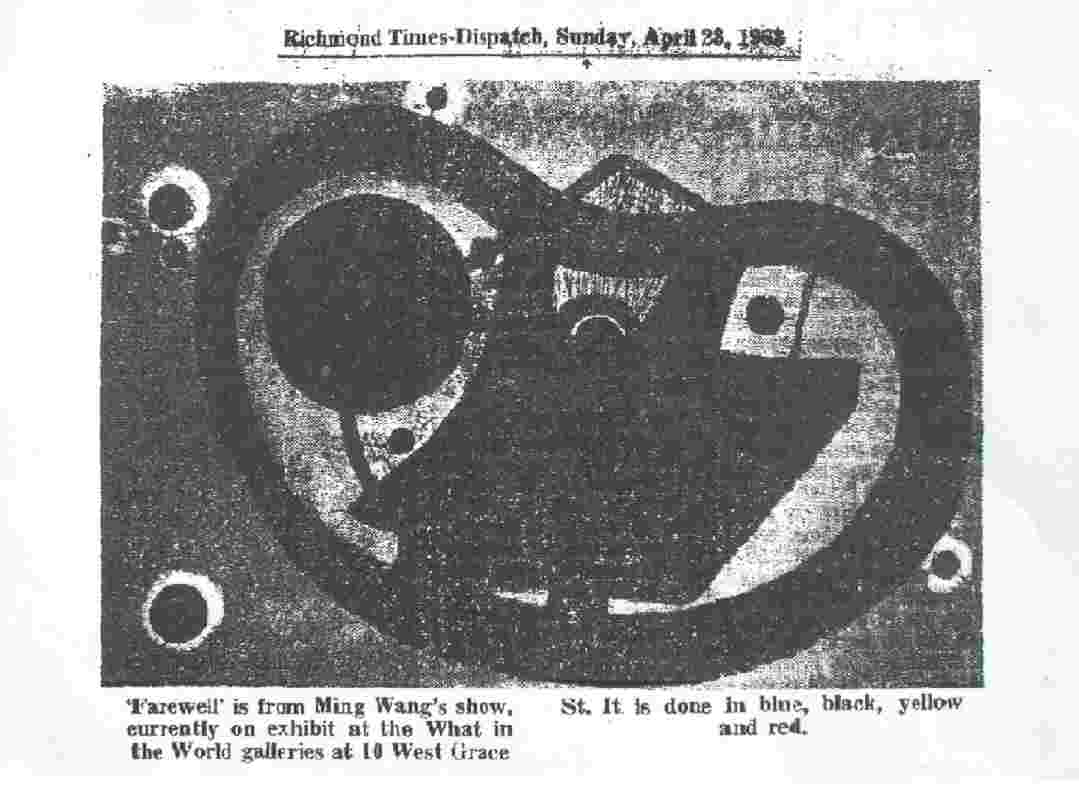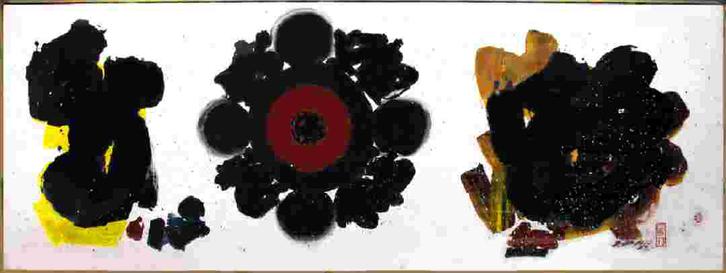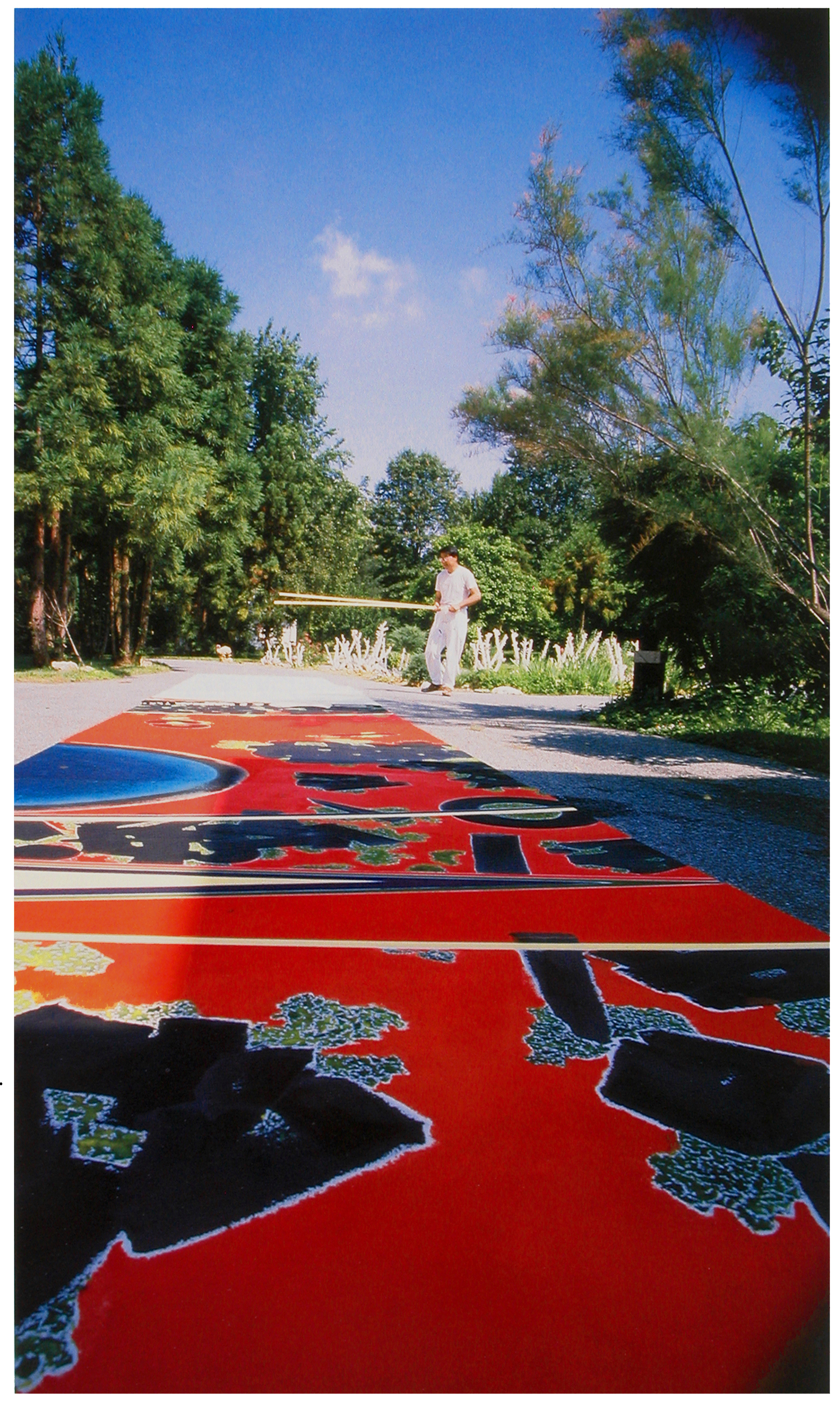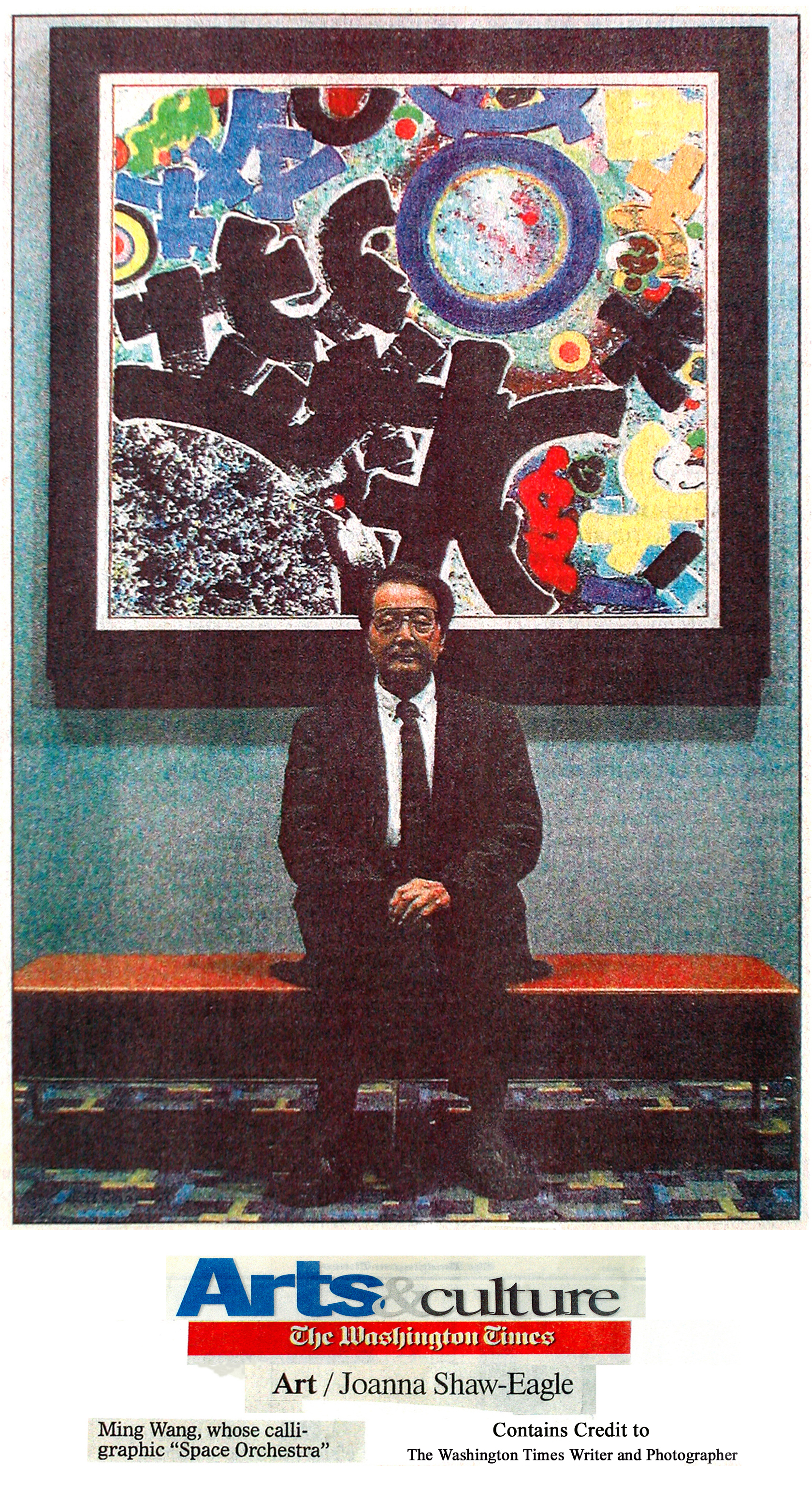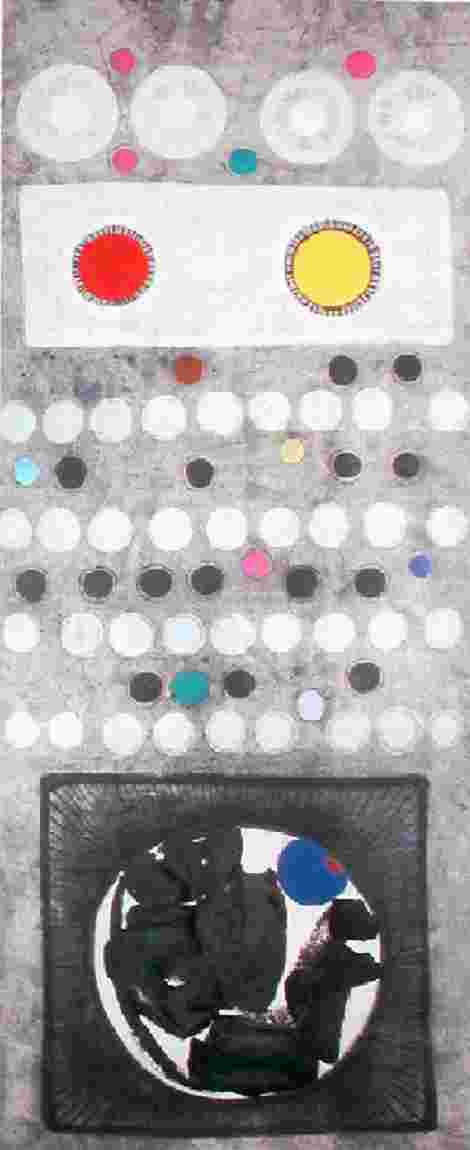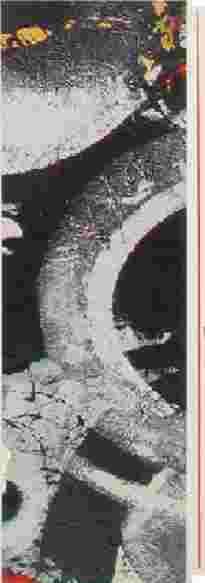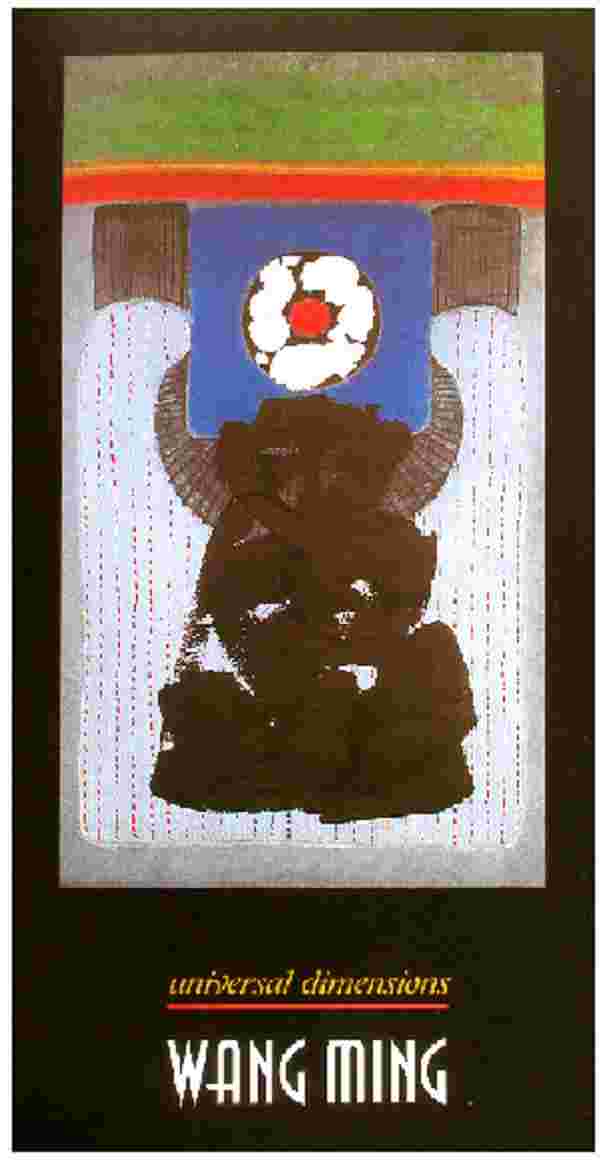Biography
April 28, 1963: Richmond Time-Dispatch, Art in Virginia, Variety Marks Collectors’ Show.
Wang Ming was born in Tianjin, China and lived there until he came to the United States in 1951. His paintings, done with a mixture of inks and acrylics on fine paper, are a happy marriage of traditional Chinese disciplines with Western art as it has been handled by Miro and Klee. His works are abstract, and marked with good design and extremely sensitive use of color. In Expectation, for instance, there is a rainbow of colors so subtly worked that their richness and variety are at first hidden. I found his works delightful and recommend them highly.
Farewell is from Ming Wang’s show, currently on exhibit at the What in the World galleries at 10 West Grace St.
June 11, 1961: Washington Star News, by Frank Geitline
Mrs. Madlock has done a first-rate job and the house contains a reasonbly comprehensive survey of contemporary local art with most of its strengths and weaknesses. Good examples of this are works by Kenneth Noland, Tom Downing, May Owen, and Gene Davis. The leadership principle is most acutely is seen in the kitchen with two paintings by Wang Ming.
1974: The Washington Post by Gene Baro
Now National Art and Frame’s proprietor, who has sometimes also shown at the Franz Bader Gallery on Pennsylvania Avenue, is having a museum show on his own, at the Corcoran Gallery of Art, July 30, 1974 - January 15, 1975. It’s a beauty. There is the sense of absolute rightness. But also virtuosity is not insisted upon; there is fancifulness, an imaginative play, that unfolds principally as sheer energy.
April 9, 1977: The Washington Post, by Paul Richard
“The new Cosmos Series paintings of Wang Ming, on view through April 16 at the Bader Gallery, look, in reproduction, as if they were enormous. Actually, they are tiny. Wang Ming’s little paintings hint at skies and galaxies. He has looked at works by Jackson Pollock, and other action painters, but his splatters and his drips are governed by a calligrapher’s control. Wang Ming has shown larger works at Bader’s often in the past. It turns out he’s a miniaturist who has found his scale. This is his finest show.”
1979: Brooklyn Museum, Brooklyn, New York.
Invitation of the exhibition “The Rhythm of Brush”
1980: Brooklyn Museum, Brooklyn, New York
American Drawing in Black & White: 1970-1980, by curator Gene Baro. “The visitors are invited to enjoy the rich variety of marks and means used in attacking subjects that range from meticulous representational rendering to extemporaneous gesture.” Included among many other artists, were Anni Albers, Jasper Johns, William De Kooning, Robert Rauschenberg, Jack Tworkov, Robert Motherwell and Andy Warhol.
1982: The Washington Post, by Jo Ann Lewis
“His show at the Marvin Center at George Washington University, where he teaches calligraphy, should help clarify the unique nature of his art . ... ‘Independent Reality,’ in which dramatic curves dance across an opened scroll, taking on a life of their own-in any language. The show is filled with the artist’s very special of visual poetry.”
March 23 - July 31, 1997: Asian Traditions/Modern Expressions Asian American Artists and Abstraction, 1945 – 1970
This was organized by the Jane Voorhees Zimmerli Art Museum Rutgers, The State University of New Jersey New Brunswick, New Jersey. The senior curator Jeffrey Wechsler reviewed each artist for this traveling group exhibition, including C. C. Wang, Chen chi, Kenzo Okada, Isamu Noguchi.
March 26, 1997: The New York Times, by Holland Cotter
"Ming Wang’s 'Respect for Tradition' a calligraphic mandala in which writing and painting come indissolubly together.”
1999: Towards a Society for All Ages: World Artists at the Millennium
Presented in Celebration of The International Year of Older Persons, an exhibition which took place in The United Nations, New York City, New York.
1999: The Qingdao International Artists Show, Qingdao, China
Celebrating the coming of the 21st century Qingdao Museum of Fine Arts, Qingdao, China.
October 12, 2000: Fairfield University, Fairfield, Connecticut
One Man exhibition introduced by Senior Curator Jeffrey Wechsler, Zimmerli Art Museum, Rutgers University. In the show announcement, Wechsler noted: “Partaking of so many aspects of art, life, and philosophy, the art of Ming Wang is one that delights in the wonderful complexity of the natural and spiritual worlds. His art freely embraces and incorporates that vitalizing complexity, but does so in an utterly natural way. Through his artistry, emotion, and understanding, Ming Wang organizes constellations of shape, symbol, and color into revelations of the deeper reality of the universe—and expressions of sheer visual joy.”
September 4 – December 17, 2000: Thomas J. Wal-h Art Gallery, Fairfield University, Fairfield, CT
Gallery Director Diana Mille Ph.D. introduced a show of work by Wang Ming by saying: It is with great honor that we begin the scholastic year at the Thomas J. Wal-h Art Gallery with Universal Dimensions – scrolls and screens by contemporary artist Wang Ming. I am extremely thankful to the artist for sharing with us his timeless sense of beauty, balance and poise in this new, and often unforgiving, millennium... May each of us take away from this exhibition a fragment of the artist’s tranquility and grace as we make our spiritual journey in life.
2000: The New York Times by William Zimmer
“The Fairfield University October 15 exhibition that features calligraphy can discourage viewers because the material is ultimately inaccessible and too complex for a casual visit. But Mr. Wang does not let such a mood set in because he employs a boldness and color sense that remind viewers of Pop Art, as well as innovative formats that keep the audience on their toes. He also hints that deep mysteries are conveyed by his inviting schemes. What visitors are treated to in this exhibition is a deft balance act.”
October 12, 2000: Fairfield University, Fairfield, Connecticut.
Senior Curator Jeffrey Wechsler, Zimmerli Art Museum, Rutgers University, introduced this one-man exhibition by saying:
The current exhibition of art by Wang Ming approximates the infinite by working on surfaces that extend far beyond our normal expectations and beyond our visual ability to take it all in at once. In this Exhibition, are scrolls and 'books' that reach thirty feet or more in extension. The scrolls, of course, refer back to that venerable format of traditional Chinese art. The books are accordian-fold arrangements, often made of individual panels mounted and connected side to side to produce long, panoramic images, and finished by creating front and back covers which also bear imagery. These may be viewed and displayed panel by panel, or fully extended, or in any section or part; in this way the artist implies that all parts of the universe are equal and sometimes apparently independent, yet are ultimately interconnected parts of a whole - nature, the universe, the Tao. Adjacent panels frequently present yin-yang contrast - black and white, contained and active shapes, organic and geometric forms, volumes and voids.
The Unity of the Universe
The Symbol of Apple: Past and Present
"Any true work of art has the quality of enlightening the human soul," Wang Ming has written. "I try to express the limitlessness of the cosmos...From the cosmos and upon the earth, I unite what I see, what I perceive, and what I know,...Every dot, every line, and every form in my paintings serve as symbols for things in the universe." This is evidently an individual who strives in his art to literally engage the universe, in the all-encompassing Taoist sense, and viewers of his work are offered the opportunity to discover some of the intriguing methods he has devised to attain this ambitious goal. Circular motifs have historically symbolized the cosmos, the earth, spirituality, and oneness. Wang Ming uses the circle in this way, as in the progression of blue circles with imagery suggesting cosmic views that sweep through his book Beyond Tangible Phenomena. However, modern scientific approaches to circular images inform Small Universal Views, wherein the circles can be seen as the round viewing fields of either a microscope or a telescope, cleverly conflating the very small and the vast, and invoking the interconnectness of Taoist cosmology.
As the essense of the cosmos is partially understood through the contemplation of outer space and the void, Wang Ming seeks to free his art of standard references to up and down, or right and left - and especially to release his imagery from gravity. Thus, much of his work has no true final orientation, and he frequently signs his work on a diagonal (or even several times, at different angles, some "upside-down" to each other). Finally, Wang Ming acts upon the universal/Taoist infinteness in terms of time; he readily reworks or adds to compositions from years or even decades past, so that certain works may have undergone several transformations over the course of thirty years or more (and bear multiple dates attesting to those changes).
Partaking of so many aspects of art, life, and philosophy, the art of Wang Ming is one that delights in the wonderful complexity of the natural and spiritual worlds. His art freely embraces and incorporates that vitalizing complexity, but does so in an utterly natural way. Through his artistry, emotion, and understanding, Wang Ming organizes constellations of shape, symbol, and color into revelations of the deeper reality of the universe - and expressions of sheer visual joy.
A Perfect Unity
April 17, 1980: The Hatchet, by Penelope Eu
“ Ming Wang, who teaches Chinese calligraphy at GW, never thought he would be an artist. … ‘I always have a question why humans, who have such a cultural background, still fight over new reasons, and lose life, happiness. So all these questions of life are my staring point as an artist. From there I try to express myself and find myself.”
July 8, 1982: The Washington Post, by Jo Ann Lewis
“His show at the Marvin Center at George Washington University, where he teaches calligraphy, should help clarify the unique nature of his art. … ‘Independent Reality,’ in which dramatic curves dance across an opened scroll, taking on a life of their own-in any language. The show, filled with the artist’s very special brand of visual poetry”
April 15 - October 15, 2009: Smithsonian Institutions, National Air and Space Museum
Wang Ming was honored with a one-man show titled, Universal Dimensions The Space Art of Wang Ming which was introduced by the Chief of Exhibitions Barbara Brennan. After the show ended, the museum kept seven of of the artist's paintings in its permanent art collection.
Today, modern science has redefined the cycle of our life, opening doors to many new possibilities in our future. Every one of us should share the responsibilities of living in balance within and around ourselves. In art, I open the door to peace and harmony in the continuous chain of life. Through art, I want to express the beauty of oneness to all.
Ming Wang in sculpture garden, working on Ming Wang in front of calligraphic
Welcome Painting, 1987 Space Orchestra, 1986
72” H x 600” W, 12 panels 70” H x 72” W, acrylic on canvas
acrylic on canvas Credit to The Washington Times
Photo by: Cynthia Brumback 1987 copyright Writer and Photographer
